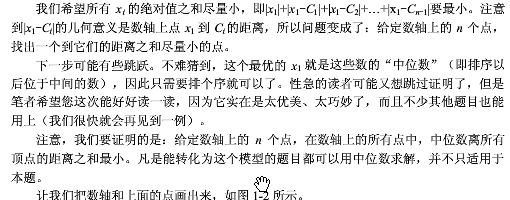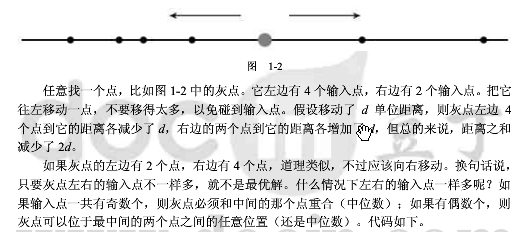Problem
A Communist regime is trying to redistribute wealth in a village. They have have decided to sit everyone around a circular table. First, everyone has converted all of their properties to coins of equal value, such that the total number of coins is divisible by the number of people in the village. Finally, each person gives a number of coins to the person on his right and a number coins to the person on his left, such that in the end, everyone has the same number of coins. Given the number of coins of each person, compute the minimum number of coins that must be transferred using this method so that everyone has the same number of coins.
The Input
There is a number of inputs. Each input begins with n(n<1000001), the number of people in the village. nlines follow, giving the number of coins of each person in the village, in counterclockwise order around the table. The total number of coins will fit inside an unsigned 64 bit integer.
The Output
For each input, output the minimum number of coins that must be transferred on a single line.
Sample Input
3 100 100 100 4 1 2 5 4
Sample Output
0 4



/*********************************
* 日期:2013-4-21
* 作者:SJF0115
* 题号: 题目11300 - Spreading the Wealth
* 来源:http://uva.onlinejudge.org/index.php?option=com_onlinejudge&Itemid=8&category=25&page=show_problem&problem=2275
* 结果:AC
* 来源:UVA
* 总结:
**********************************/
#include<stdio.h>
#include<stdlib.h>
int Money[1000001],C[1000001];
int cmp(const void *a,const void *b){
return *(int *)a - *(int *)b;
}
//绝对值
int abs(int a,int b){
if(a < b){
return b - a;
}
else{
return a - b;
}
}
int main ()
{
long long int i,N,Min,Sum,M;
//freopen("C:\\Users\\XIAOSI\\Desktop\\acm.txt","r",stdin);
while(scanf("%lld",&N) != EOF){
Sum = 0;
Min = 0;
//N个人
for(i = 0;i < N;i++){
scanf("%d",&Money[i]);
Sum += Money[i];
}
//平均值
M = Sum / N;
C[0] = 0;
//初始化C数组
for(i = 1;i < N;i++){
C[i] = C[i-1] + Money[i] - M;
}
//排序,选择中位数
qsort(C,N,sizeof(int),cmp);
long long int x1 = C[N/2];
//计算转移的金币数
for(i = 0;i < N;i++){
Min += abs(x1,C[i]);
}
printf("%lld\n",Min);
}
return 0;
}